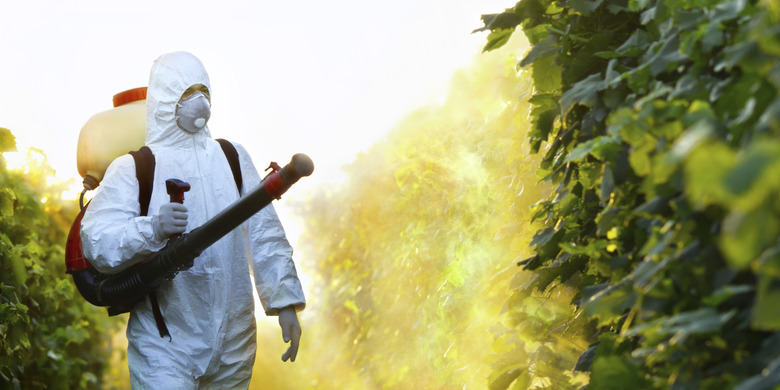Biological Vs. Chemical Pest Control
When pests threaten to overtake your garden, choosing between the myriad available control methods can be challenging. Many chemical and biological options exist to help manage pests and maintain healthy, productive garden plants. Understanding some of the differences between chemical and biological alternatives can help you choose the best pest management approach for the problems at hand.
Chemical Controls
Chemical Controls
Chemical pesticides, often based on man-made substances, are designed to reduce the vitality of pest populations while leaving your plants unharmed. Chemical controls eradicate common pests in several different ways. Some kill pests as soon as they come in contact with the chemical. Others disrupt the pest's ability to reproduce. Other chemical controls limit physical growth or influence pest behavior in ways detrimental to their lives. Most chemical controls are fast acting and effective. They often offer control over many different insects at once and the various life stages of different pests.
Biological Alternatives
Biological Alternatives
Biological control methods use living organisms such as natural predators, parasites and pathogens to control pest populations on garden plants. They include beneficial bugs, such as lady beetles and parasitic wasps, which prey on harmful insects but leave your plants untouched. Many beneficial insects are commercially available, and they can quickly reduce pests to manageable levels. Biological pesticides are based on naturally occurring organisms that prove toxic for certain insects. Bacillus thuringiensis (Bt), for example, is a bacterium that kills caterpillars and other larvae after they feed on treated plant leaves. Planting certain plants to attract and keep beneficial insects helps control harmful insects as well.
Benefits to Both
Benefits to Both
Chemical controls are often inexpensive and readily available. Many have proven safe and effective for decades and remain in popular use due to their efficiency and quick results. Scientific advances have created many new chemical pesticides that mimic and, in some cases, improve on the effectiveness of natural substances. As gardeners seek out more natural and organic gardening solutions, biological controls have grown in use. Products have become more widely-available and are often comparable to chemical solutions in cost. Biological controls generally have a more limited effect on the environment.
Additional Considerations
Additional Considerations
While chemical controls are often effective, they are usually seasonal and require reapplication with each growing season. Biological controls may take longer to deliver the desired results, but the benefits can last well beyond your initial investment. Many chemical pesticides persist in the environment, and pest populations can build up resistance to chemicals over time. However, many invasive pests were imported and lack natural predators in their new environment, making biological control challenging in some cases.
Integrated Controls
Integrated Controls
The best options for controlling garden pests often combine a combination of chemical and biological controls. This approach is known as integrated pest management or IPM. It focuses on combining methods to effectively control pests, while keeping the environmental impact as low as possible. Dense pest infestations may require the potency of chemical controls, but IPM uses them as a last resort. Even natural pesticides may be powerful poisons, so always wear protective clothing, gloves and protective eyewear when working with pesticides, whether chemical or biological.
Cite This Article
MLA
Campbell, Damien. "Biological Vs. Chemical Pest Control" sciencing.com, https://www.sciencing.com/biological-vs-chemical-pest-control-6626772/. 24 April 2017.
APA
Campbell, Damien. (2017, April 24). Biological Vs. Chemical Pest Control. sciencing.com. Retrieved from https://www.sciencing.com/biological-vs-chemical-pest-control-6626772/
Chicago
Campbell, Damien. Biological Vs. Chemical Pest Control last modified August 30, 2022. https://www.sciencing.com/biological-vs-chemical-pest-control-6626772/
